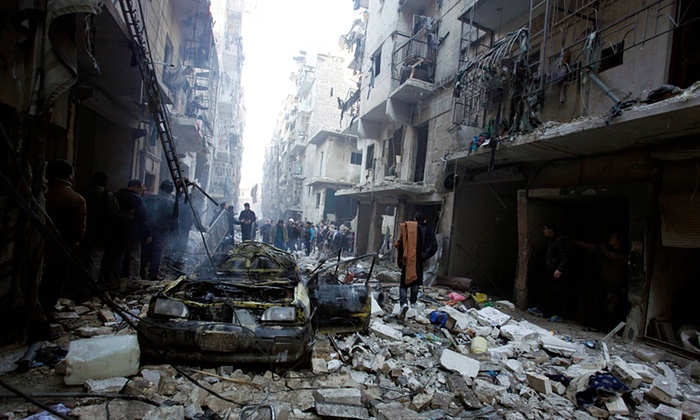Urban warfare has altered the nature of humanitarian work, says Red Cross chief

Clár Ní Chonghaile - Guardian Newspaper
Photograph: Molhem Barakat/Reuters
The world’s cities are becoming increasingly overcrowded and violent, with conflict and the increasing prevalence of urban gangs armed with military-grade weapons creating development challenges with which the international community is struggling to cope, according to the president of the International Committee of the Red Cross.
Modern warfare – in all its splintered, increasingly urban messiness – has altered the humanitarian space, said Peter Maurer, changing the world of emergency relief beyond recognition. The sight of ICRC trucks ferrying relief to thousands of displaced people in the countryside is no longer the norm; today, bombs fall on cities, where thousands still live. Humanitarians need to reach these people and repair damaged services, like water systems, while simultaneously negotiating with different armed actors, Maurer explained.
“We see a transformation of warfare from the big armies and battlefields in open spaces to a fragmentation of armed groups and smaller armies, which move into city centres, which increasingly become the theatre of warfare,” he said.
“It’s not by chance when we look at the 15 largest conflicts in the world, in which ICRC is active, the emblematic names that come to mind are Aleppo, Homs, Luhansk, Donetsk, Maiduguri, Aden.”
As the terms of humanitarian engagement have altered, so too has the scale. Turbo-urbanisation has led to swollen populations, said Maurer, creating unprecedented levels of urban vulnerability.
“Four billion people live in cities today. One billion are living in provisional or slum-type settlements and at the same time, 600 cities in the world make up two-thirds of global GDP … Cities are drivers of growth and wealth and at the same time cities are becoming increasingly violent,” said Maurer.
He called on the international community to ramp up its support for these vulnerable people, reprioritising funding and delivering aid as close to crises as possible, notwithstanding possible political and operational difficulties.
“It is definitely complex,” Maurer conceded. “But my question would be: when else [to act] but today when you see … such a direct impact of the suffering in … the enormous flux of migration and displacement? When else, if not now, will we find another political formula to reprioritise some of the work?”
The ICRC, which was founded in 1863, is mandated to intervene under the Geneva conventions, but distinctions between international warfare and internal armed conflict seem increasingly anachronistic. And while ICRC’s neutrality and negotiating skills remain paramount, the context is shifting, Maurer said.
“Some of the competencies and skills that we have acquired over 150 years will remain the same, because this organisation has always been committed to talk to all sides. The problem is that in today’s city realities, all sides may not mean two or three groups, but 30, 40, 50,” he said. As well as the spread of full-blown conflict to cities, there are other, longer-term risks from other violence, particularly in Latin America.
“Urbanisation, poverty, youth unemployment are leading to violence-prone cities … we are confronted in cities with increasingly political-military activity, criminal violence and inter-community violence,” he said, noting that the strands were not necessarily separate.
“We tend to think that Syria is about an armed conflict, and Medellín [in Colombia] is about long-term urban violence … These situations start to superimpose themselves upon one another. We see Latin American cities where gangs have military equipment that dwarfs some of the military equipment we see in conflict. They have light weapons of the same sophistication.”
Red Cross says conflict in Syria and Iraq causing 'alarming' $82m hole in finances.
Maurer noted that in some Latin American cities, death tolls over certain periods can rival those found in war zones. The challenge for the ICRC and similar organisations is to work with local authorities and institutions such as the police.
“This is not a temporary disruption by a military operation. It’s a structural problem and it forces you to envisage humanitarian work of a different kind … not as short-term relief effort but more as long-term effort to support communities to deal with the scourge of violence,” said Maurer. Activities could include youth employment programmes, support for social housing and work with detainees and former detainees. Maurer said the ICRC was also engaged in “invisible but not ineffective” work with armed groups and armies to train personnel on the protection of civilians. Progress was being made, but “the man not killed doesn’t make the news”, he said.
What has made the news are the thousands of deaths in seemingly intractable conflicts stretching from the eastern reaches of Ukraine, through the centre of Africa and into the Middle East, many of which have contributed to what UN officials describe as “an age of unprecedented mass displacement”.
The ICRC’s operational budget has risen by almost 50% over the past three years. Maurer said donors’ structures were being outpaced by local realities.
“They have development funds and humanitarian funds, and these funds are invested in what they have been created for, but the reality moves on,” he said.
“My bottom line would be that the money is not going to the most fragile and vulnerable contexts. This leads to more instability and forces people to move.”
Maurer, who is a member of the World Economic Forum’s Global Agenda Council on Fragility, Conflict and Violence, added that an on-the-ground presence was imperative, despite the risks: “Very often development agencies or even some of the humanitarian actors choose the … more comfortable type of work, where it is safe, while the more important work has to be done where it is profoundly unsafe.”
|